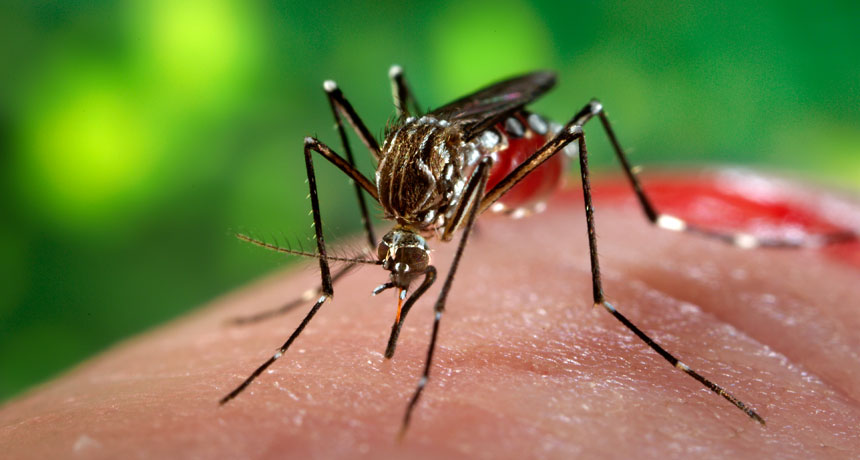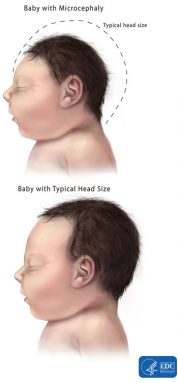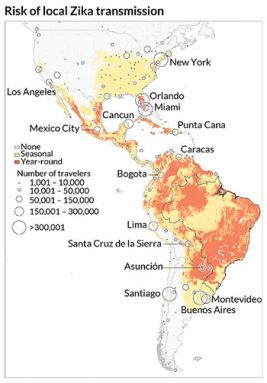Zika virus raises alarm as it spreads in the Americas
Mosquito-borne disease is linked to birth defect in Brazil

The Aedes aegypti mosquito is one of two species that can transmit the Zika virus, now spreading through Latin America.
James Gathany/CDC
By Meghan Rosen
The latest virus to break out of the tropics may be the most frightening.
It’s called Zika virus. It has already blazed across Brazil. And it has pressed northward into Central America and Mexico. Now it is poised to jump to the United States. Infection typically causes minor or even no symptoms. But in pregnant women, it’s been linked to a birth defect called microcephaly. The condition leaves babies with abnormally small heads and partially developed brains.
Zika virus is an arbovirus. This type of virus is one of many that are spread by insects such as mosquitoes and ticks. International travel may make it easier for these viruses to spread across the globe. Because of this, the rapid emergence — and reemergence — of little-known viruses such as Zika may be the new normal, suggest Anthony Fauci and his colleague David Morens. Their warning appears January 13 in the New England Journal of Medicine.
Zika virus is just the latest mosquito-borne disease to reach the Americas. Dengue fever causes severe headaches, joint and muscle pain and other symptoms. It can be deadly. “Dengue hit with a vengeance in the ’90s,” Fauci notes. He is director of the National Institute of Allergy and Infectious Diseases in Bethesda, Md. West Nile arrived in 1999. Chikungunya showed up in 2013. “Lo and behold, now we have Zika in 2015 and 2016,” says Fauci. “This is a disturbing, remarkable pattern.”
Already, travelers have brought Zika home to Texas, Hawaii, Illinois and other states. The virus doesn’t seem to have taken hold in U.S. mosquitoes yet. But the United States has warm, humid regions, pockets of poverty and a ready fleet of mosquitoes capable of carrying the virus. Those are all the right ingredients for an outbreak, says Peter Hotez. He is a pediatrician and microbiologist at Baylor College of Medicine in Houston, Tex.
“We’ve been wringing our hands about Ebola,” he says. An outbreak of the disease killed more than 11,000 people in West Africa in 2014 and 2015. But “Ebola was never a threat to the Western Hemisphere.”
Zika is.
A virus emerges
Scientists first collected Zika virus in 1947 from a rhesus monkey. The monkey was part of an infectious-disease study in the wetland-edged Zika forest of southern Uganda in Africa. For decades, the virus flitted between monkeys and mosquitoes. It infected humans only rarely. It never infected anyone outside of Africa and Asia — until 2007. That’s when Zika escaped into the Pacific. It caused an outbreak on Yap Island in the Federated States of Micronesia. The virus was spotted in French Polynesia next, in 2013. It came to Easter Island in 2014. And in May 2015, the first confirmed cases cropped up in Brazil. There, Zika thrived. It quickly gained a firm foothold in the Americas.
In less than nine months, Zika infected as many as 1.3 million people in Brazil. The European Center for Disease Prevention and Control reported that number on December 10. Some estimates put the number even higher. Zika virus has now spread through 18 countries and territories in Latin America and the Caribbean, report the Pan American Health Organization and World Health Organization.
“The cat’s out of the bag now,” Hotez says. “Zika virus is going to be all over.”
On January 15, the U.S. Centers for Disease Control and Prevention (CDC) issued warnings for people traveling to countries with Zika. Pregnant women, in particular, should be especially cautious, the CDC advised.

In Brazil, the number of babies born with microcephaly is steadily ticking up. In 2015, the country recorded roughly 20 times as many cases as in previous years. New cases — sometimes hundreds — appear every week. On January 20, Brazilian health officials reported a total of 3,893 cases, 363 more than a week earlier.
Ernesto Marques is a public health researcher at the University of Pittsburgh in Pennsylvania. He estimates that roughly 1 in 150 babies were born with the birth defect in Brazil. He based that estimate on number of babies born in the country in 2015 and the number of microcephaly cases that year.
“This is just a huge number,” he says. “And it’s in an outbreak that has just started.”
Because of the potential risk for babies, officials in Ecuador, El Salvador, Jamaica and Columbia have advised women not to get pregnant this year.
That Zika might harm fetal brains isn’t all that surprising, says Carlos Brisola Marcondes. He studies disease-carrying insects at the Federal University of Santa Catarina in Brazil. In lab mice, Zika virus makes a beeline for the brain. “It causes serious damage,” Marcondes says. Nerve cells break down and brain tissue softens.
Neurological problems have also been observed in infected human adults. In the 2013–2014 French Polynesia outbreak, at least 73 people developed neurological conditions. One of these was Guillain-Barré syndrome, which can cause paralysis. Health officials have linked the condition to Zika virus infection in the current outbreak as well.
Early this year, scientists discovered the most concrete clues yet that Zika virus can cause microcephaly. They found genetic traces of Zika in the amniotic fluid of two pregnant women carrying fetuses diagnosed with the birth defect. (Amniotic fluid surrounds the fetus inside a pregnant woman.) They also found such evidence in four babies who were miscarried or died shortly after birth.
“The evidence is very, very strong,” says Marques. So far, though, only a few babies have been tested.
Searching for answers
Marques and coworkers in Brazil, England and the United States have begun a study to examine even more babies. The researchers aim to enroll 200 infants with microcephaly and 400 infants without the birth defect. They will look for traces of Zika in maternal blood, umbilical cord blood, amniotic fluid and other tissues.
At this point, Marques isn’t expecting to figure out how the virus may cause brain damage. He just wants enough cases to tease out any link between Zika and microcephaly. “If we see signs of viral infection in the placenta or the blood or brain tissue of these babies, that would strengthen the case,” he says. The researchers have already begun enrolling people. Marques hopes to recruit all 600 participants by June or July.
Scientists still have a lot to learn about Zika virus, Hotez says. They still don’t know how the virus passes from mother to fetus. And it is unclear what exactly Zika virus does to developing brains and if it does indeed cause microcephaly.
Currently, scientists have no antiviral therapy for Zika infection and no vaccine. Developing a vaccine could take years, Fauci says. “Even though we started aggressively on it a month or two ago, it’s going to take a while before we get one.”

More than 60 percent of U.S. residents live in areas threatened by Zika virus (at least during warm seasons), the team found. For southern states, especially, “there’s a potential for ongoing transmission,” says Isaac Bogoch. He is a tropical infectious diseases physician at Toronto General Hospital in Canada. He led the Lancet study.
Still, that doesn’t mean a Zika virus outbreak will come soon, he says. And it doesn’t mean it is inevitable. The virus doesn’t ordinarily pass from person to person (though it may be transmitted sexually). And it might not move beyond a handful of confined cases. After all, chikungunya and dengue virus ride the same mosquitoes as Zika. But they haven’t hit the United States especially hard.
For all these viruses, getting control of an outbreak requires getting rid of mosquitoes, Marcondes advises in a recent review. It was published December 22 in the Journal of the Brazilian Society for Tropical Medicine. “Preventing [mosquito] breeding is the only way,” he says.
Already, Brazil is trying out an approach to cut wild mosquito populations by changing mosquitoes’ genetic material (this is called genetic engineering) so they can’t reproduce and then releasing them.
Fauci agrees that controlling mosquito populations is key. But the recent emergence of so many tropical viruses might also require some new defensive strategies, he says. If scientists could find an antiviral drug that targeted the larger group of viruses that Zika belongs to, for instance, they could knock out several threats.
“You would automatically get chikungunya, West Nile, yellow fever, Zika and dengue with one shot,” he says.
Power Words
(for more about Power Words, click here)
amniotic fluid The fluid that surrounds a fetus inside a pregnant woman or animal.
arbovirus A group of viruses, such as Zika virus and dengue, that are transmitted by mosquitoes, ticks or other arthropods.
antiviral A virus-killing substance prescribed as a medicine.
cell The smallest structural and functional unit of an organism. Typically too small to see with the naked eye, it consists of watery fluid surrounded by a membrane or wall. Animals are made of anywhere from thousands to trillions of cells, depending on their size.
Centers for Disease Control and Prevention, or CDC An agency of the U.S. Department of Health and Human Services, CDC is charged with protecting public health and safety by working to control and prevent disease, injury and disabilities. It does this by investigating disease outbreaks, tracking exposures by Americans to infections and toxic chemicals, and regularly surveying diet and other habits among a representative cross-section of all Americans.
chikungunya A tropical disease that has been crippling large numbers of people in Africa and Asia. It’s caused by a virus that is spread by mosquitoes. It recently has been spreading widely throughout warm nations. More than 3 million people have suffered through its initial flu-like symptoms. A large share may also go on to develop intense pain in their muscles and joints that can last months to years. There is no cure or vaccine
climate The weather conditions prevailing in an area in general or over a long period.
dengue fever A potentially lethal infectious disease transmitted by mosquitoes. No vaccine yet exists to prevent infection with the virus responsible for the disease, which causes high fevers, severe headache, joint pain, pain behind the eyes, rash, bone pain and sometimes mild bleeding. A more severe form of the disease, known as dengue hemorrhagic fever can cause uncontrolled bleeding if not treated right away.
Easter Island A small island in the Pacific located some 3,500 kilometers (2,200 miles) west of Chile.
Ebola A family of viruses that cause a deadly disease in people. All cases have originated in Africa. Its symptoms include headaches, fever, muscle pain and extensive bleeding. The infection spreads from person to person (or animal to some person) through contact with infected body fluids. The disease gets its name from where the infection was first discovered in 1976 — communities near the Ebola River in what was then known as Zaire (and is now the Democratic Republic of Congo).
Federated States of Micronesia A nation consisting of a scattered group of islands in the western Pacific Ocean.
fetus (Adj.fetal) The term for a mammal during its later-stages of development in the womb. For humans, this term is usually applied after the eighth week of development.
French Polynesia A nation consisting of more than 100 islands in the South Pacific.
genetic Having to do with chromosomes, DNA and the genes contained within DNA. The field of science dealing with these biological instructions is known as genetics. People who work in this field are geneticists.
genetic engineering The direct manipulation of an organism’s genome. In this process, genes can be removed, disabled so that they no longer function, or added after being taken from other organisms. Genetic engineering can be used to create organisms that produce medicines, or crops that grow better under challenging conditions such as dry weather, hot temperatures or salty soils.
infection A disease that can spread from one organism to another.
insect A type of arthropod that as an adult will have six segmented legs and three body parts: a head, thorax and abdomen. There are hundreds of thousands of insects, which include bees, beetles, flies and moths.
Latin America Nations in the Americas south of the United States, most of which now speak Spanish as their native tongue. The major exception within this region: Brazil, which speaks Portuguese.
microbiology The study of microorganisms, principally bacteria, fungi and viruses. Scientists who study microbes and the infections they can cause or ways that they can interact with their environment are known as microbiologists.
microcephaly A condition that leaves babies with abnormally small heads and partially developed brains.
miscarriage The death of a fetus in a pregnant animal, especially a human.
neurology A research field that studies the anatomy and function of the brain and nerves. People who work in this field are known as neurologists (if they are medical doctors) or neuroscientists if they are researchers with a PhD.
neuron or nerve cell Any of the impulse-conducting cells that make up the brain, spinal column and nervous system. These specialized cells transmit information to other neurons in the form of electrical signals.
outbreak The sudden emergence of disease in a population of people or animals. The term may also be applied to the sudden emergence of devastating natural phenomena, such as earthquakes or tornadoes.
paralysis The inability to willfully move muscles in one or more parts of the body. In some cases, nerves that carry the signal to move may have been severed or damaged. In other cases, the brain may be the source of the problem: It may fail to understand or act on a nerve’s signal to move.
pediatrics A field of medicine that has to do with children and especially child health. A doctor who works in this field is known as a pediatrician.
pinkeye A highly contagious bacterial infection that inflames and reddens the conjunctiva, a membrane that lines the eyelids’ inner surface.
placenta A sac that connects the embryo to the uterus in most mammals. The placenta supplies oxygen and nutrients to the developing embryo. It also takes away waste.
rhesus monkey (also called rhesus macaque) A small brown macaque with red skin on the its face and rump, native to southern Asia. It is often kept in captivity and is widely used in medical research.
tick A small eight-legged blood-sucking arthropod, related to spiders and mites. Although they look like bugs, these are not insects. They attach themselves to the skin of their host and feed on their blood. But in the process, they may spread any germs that could have been present in the blood of an earlier host.
tropics The region near Earth’s equator. Temperatures here are generally warm to hot, year-round.
umbilical cord This structure connects a fetus to the placenta inside its mother’s womb and provides blood filled with oxygen and nutrients.
vaccine A biological mixture that resembles a disease-causing agent. It is given to help the body create immunity to a particular disease. The injections used to administer most vaccines are known as vaccinations.
virus Tiny infectious particles consisting of RNA or DNA surrounded by protein. Viruses can reproduce only by injecting their genetic material into the cells of living creatures. Although scientists frequently refer to viruses as live or dead, in fact no virus is truly alive. It doesn’t eat like animals do, or make its own food the way plants do. It must hijack the cellular machinery of a living cell in order to survive.
West Nile disease A disease caused by a virus that is transmitted by mosquitoes. Most people develop no symptoms. But about one in five infected people will get a headache, body aches, joint pains, vomiting, diarrhea, fever or some rash. A very small share of infected people will also develop coma, seizures or paralysis.
wetland As the name implies, this is a low-lying area of land either soaked or covered with water much of the year. It hosts plants and animals adapted to live in, on or near water.
yellow fever A disease that creates flu-like symptoms that can start with fever, chills, headache, backache and vomiting. Roughly 15 percent of patients may go on to develop more serious disease. This can lead to uncontrolled bleeding, the failure of multiple internal organs — and death.
Zika virus A virus that can be transmitted to humans via mosquitoes. About 20 percent of infected people get sick. Symptoms include a slight fever, rash and pinkeye and usually fade quickly. A growing body of evidence suggests that the virus could also cause a devastating birth defect — microcephaly. Evidence suggests it may also cause neurological conditions such as Guillain-Barré syndrome.







